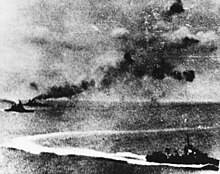Force Z
The Force Z (German about Combat Group Z ) was a British- Australian naval unit, which was put together shortly before the start of the Pacific War in World War II on October 27, 1941 under the leadership of Admiral Sir Tom Phillips .
The Force Z achieved fame when on December 10, 1941, the battleship HMS Prince of Wales and the battle cruiser HMS Repulse , which was subordinate to the Association, were caught in a Japanese air raid off the coast of Malaysia and both were sunk . It was a clear sign of the strategic loss of importance of capital ships in relation to land and sea-based air forces, which was already emerging in 1941 .
history
background
Lineup of the Force Z
Due to the increasing danger of war in the Pacific , Prime Minister Winston Churchill saw it as essential to station an emergency squadron in the British colonial areas in Asia . He pushed through this decision on October 20, 1941 in a cabinet meeting against many votes against. Force Z , consisting of two battleships and four destroyers, was to form the foundation for this squadron . Further ships were planned to expand the fleet in 1942, including the new aircraft carrier HMS Indomitable .
The only limited modernized battle cruiser HMS Repulse was at the time in the port of Durban in South Africa and was given the order to sail to Singapore, since another battleship next to the modern HMS Prince of Wales did not seem to be dispensable. He met the other ships there on December 2nd. Admiral Sir Tom Phillips took command of the fleet that day, and the HMS Prince of Wales became his flagship .
The arrival of the ships did not go unnoticed by the Japanese who had followed the course. As a result of the British rearmament, the Japanese fleet commander in chief Admiral Isoroku Yamamoto had a total of 36 Betty bombers moved to Indochina in order to build a powerful air fleet there.
In view of the situation, Admiral Phillips took a plane to Manila in the Philippines shortly afterwards to discuss the next steps with US General Douglas MacArthur and Admiral Thomas C. Hart . Meanwhile sighted a reconnaissance aircraft of the Royal Air Force a Japanese fleet with course southwest toward the Isthmus of Kra . The news was immediately relayed to Manila. Thereupon Phillips interrupted the conversation and went back to Singapore, where he immediately went on board his flagship.
On December 8, 1941 at around 5:35 p.m. Force Z ran in the direction of the Gulf of Siam to intercept the reported Japanese troop convoys in the South China Sea . Several cruisers and destroyers also moored in Singapore were left behind because they were either too slow or were being repaired. Phillips knew that the Royal Air Force, equipped with only a few outdated aircraft, could not provide air security on site. However, he assumed that the Japanese planes would not be able to operate that far from their airports. In addition, up to this point - apart from the American battleships in Pearl Harbor - no ship larger than a heavy cruiser had been sunk by aircraft.
Sinking of the large combat units
On the afternoon of December 9, the formation was sighted east of the Anambas Islands , first by a Japanese submarine and later by aircraft on board the cruisers covering the convoys, and shadowed for a long time without being noticed by the British.
At about 11:00 ten aircraft on December 10 captured by the Japanese 22 Marine Air Wing , the Force Z and flew a first wave of attack, another 27 bombers and 61 torpedo armed aircraft followed a short time later. The ships fought back with violent flak fire and tried to evade, but with little success, this also due to tactical errors by Admiral Phillips.
After a total of seven waves of Japanese attacks, the HMS Repulse sank at 12:23 p.m. and tore 513 men with it. The flagship Prince of Wales followed 45 minutes later . 327 crew members went down with the ship, including Admiral Phillips and the commander, Captain John Leach . The survivors were rescued in a committed manner by the escort destroyers and brought to Singapore.
The British armed forces in Southeast Asia were severely weakened as a result; further support could not be sent as all forces in Africa and Europe were tied up. Singapore subsequently fell to the Japanese and on December 26 the last British units surrendered in Hong Kong .
List of units of Force Z
- HMS Prince of Wales - battleship
- HMS Repulse - battle cruiser
- HMS Electra - destroyer
- HMS Express destroyer
- HMS Tenedos - destroyer
- HMAS Vampire - Australian destroyer
Part of Force Z, but remaining in the dock due to repairs:
- HMS Encounter - destroyer
- HMS Jupiter - destroyer
gallery
See also
- Chronology of the Pacific War
- Force H (Mediterranean and Atlantic Operations Area)
- Force K (Mediterranean Operations Area)
literature
- Richard Hough: The Hunting of Force Z: the brief, controversial life of the modern battleship and its tragic close with the destruction of the "Prince of Wales" and "Repulse. - London: Cassell Military Paperbacks, 1999. - ISBN 0-304 -35239-X
- Martin Middlebrook and Patrick Mahoney: The Sinking of the Prince of Wales & Repulse: The End of the Battle Ship Era - New York: Charles Scribner's Sons, 1979. - ISBN 0-684-16333-0 (Paperback: Barnsley, South Yorkshire: Pen & Sword Books, 2004. - ISBN 1-84415-075-5 )
Web links
- Complete overview page about the event (English)





